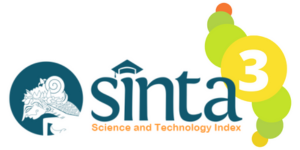DEVELOPING A MULTIMEDIA POWERPOINT PRESENTATION ON THE HUMAN CIRCULATORY SYSTEM FOR JUNIOR HIGH SCHOOL STUDENTS IN PAPUA
DOI:
https://doi.org/10.26877/bioma.v13i1.361Keywords:
Biology Subject, Human Circulatory System, Junior High School, Multimedia PowerPointAbstract
A biology curriculum consists of several topics that should be taught using appropriate media based on the type of information. The use of Multimedia PowerPoint is chosen because it is accessible without the need for an internet connection, making it a suitable solution for schools in Papua that lack infrastructure. This research aims to develop a Multimedia PowerPoint presentation on the Human Circulatory System for Junior High School students in Papua, with the goal of enhancing students' understanding of biology. The research method used is Research and Development, following the procedure outlined in the Borg & Gall Model. The developed product was reviewed by several experts and deemed viable. Subsequent assessment by students a yielded positive result. Questionnaires were used for assessment, and data analysis was conducted using percentages. The results of the development of the Multimedia PowerPoint on the Human Circulatory System are as follows: (1) The average assessment from material/content experts is 93%. (2) The average assessment from media experts is 100%. (3) The average assessment from design experts is 89%. (4) The average assessment from individual trials is 88%. (5) The average assessment from small group trials, is 90%. (6) The average assessment from large group trials is 91%. In conclusion, the Multimedia PowerPoint is a feasible instructional media for teaching the Human Circulatory System to Junior High School students, particularly in the Papua region.
References
Adebanjo, A. A. (2020). Effects of Lecture Method Supplemented with Powerpoint Presentation on Students’ Academic Achievement in Biology. KIU Journal of Humanities, [S.l.], Vol. 5 (2) p., 215-222.
Ahnaf, F. H., Rochmawati, F., Hamdala, S., & Muzemi. (2021). Pengembangan Media Pembelajaran Berbasis Animasi pada Materi Fonologi untuk Mahasiswa menggunakan PowerPoint. Ainara Journal (Jurnal Penelitian dan PKM Bidang Ilmu Pendidikan), Vol. 2 (2) , Hal. 59-65.
Darmawan, H., Simanjorang, M. M., & Nasution, H. (2022). Pengembangan Perangkat Pembelajaran Berbasis ICT Memanfaatkan Power Point, Filmora, Whtasapp Grup, Google Classroom, dan Google Formulir Untuk Meningkatkan Keefektifan Pembelajaran. Jurnal Cendekia Jurnal Pendidikan Matematika, 848-858. Https://Doi.Org/10.31004/Cendekia.V6i1.1291.
Dukhan, S., Brenner, E., & Cameron, A. (2019). The influence of lecturers’ expectations of students’ role in meaning making on the nature of their Powerpoint slides and the quality of students’ note-making : a first-year Biology class context. African Journal of Research in Mathematics, Science and Technology Education, Vol. 23 (1), 100–110, https://doi.org/10.1080/18117295.2019.1598625.
Fadhillah, R., Djulia, E., & Diningrat, D. S. (2017). The Development of Scientific Approach-Based Interactive Learning Media of Biology on the Topic of Auditory System for High School Students. International Journal of Humanities Social Sciences and Education (IJHSSE), Vol.4 (12), 127-133. http://dx.doi.org/10.20431/2349-0381.0412016.
Gall, M., Gall, J., & Borg, R. (2007). Educational research: An introduction (8th ed.). New York: Pearson Education. .
Kelly-Laubscher, R.F., M. N., & van der Merwe, M. (2017). Using the research article as a model for teachinglaboratory report writing provides opportunities for development of genre awareness and adoption of new literacy practices. English for Specific Purposes, 48, 1–16.
Khan, T., Hassali, M., & Rasool, S. (2013). A study assessing the impact of different teaching modalities forpharmacy students in a Cardio-Pulmonary Resuscitation (CPR) course. Saudi Pharmaceutical Journal, 21(4), 375–378.
Microsoft. (2024). Retrieved from MICROSOFT: https://www.microsoft.com/id-id/
Mokalu, Y. B., Repi, R. A., & Ngangi, J. (2021). Developing instagram-based biology animation learning media for junior high school student. International Journal of Advanced Education and Research, Vol. 6 (3), 45-48.
Okereke, I. E., & Nzewi, U. M. (2020). Extent Of Biology Curriculum Content Delivery With Powerpoint Presentation in Secondary Schools: The Challenges Of Implementation and Solution. Journal of the Nigerian Academy of Education Vol. 16, No.1, 159-171.
Permatasari, M. I., Pratiwi, I., Sazwita, R. A., & Ahza, S. (2022). Biodigital Human: Media Pembelajaran di Era New Normal. BIOMA: Jurnal Ilmiah Biologi, 11(1), 50-60.
Rhodes, D. V., & Barshick, M. R. (2021). Adapting a Bacterial Unknowns Project to Online Learning: Using Microsoft PowerPoint To Create an Unknowns Identification Simulation. Journal of Microbiology & Biology Education Vol. 22, No. 2, DOI: https://doi.org/10.1128/jmbe.00104-212878.
Sariam, S., & Harahap, H. S. (2022). The Influence of Powerpoint-Based Discovery Learning Models on Biology Student Learning Outcomes. Formatif: Jurnal Ilmiah Pendidikan MIPA, Vol. 12 (1), 127-134. DOI: http://dx.doi.org/10.30998/formatif.v12i1.12000.
Stacy, E., & Cain, J. (2015). Note-taking and handouts in the digital age. American Journal of Note Pharmaceutical Education,79(7), article 107.
Taculod, N. J., & Arcilla Jr., F. E. (2020). Enhancing the Academic Performance and Learning Interest in Biology of Grade 10 Students Using Expanded PowerPoint Instruction. SMCC Teacher Education Journal, Vol. 2, https://dx.doi.org/10.18868/cte.02.060120.05.
Wahyuddin, Jamilah, Damayanti, E., & Maulana, A. (2022). Development of Animation-Based Learning Media with Music and Song Lyrics on The Cell Division Material At Al-Bahra High School Jeneponto Regency. BIOMA: Jurnal Ilmiah Biologi, 11(2), 151-164. https://doi.org/10.26877/bioma.v11i2.11490Websites:http://journal.upgris.ac.id/index.php/bioma/index.








